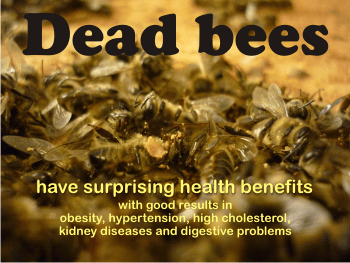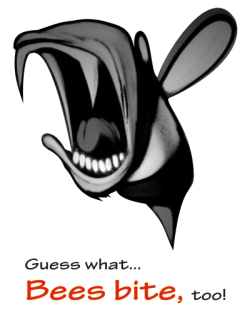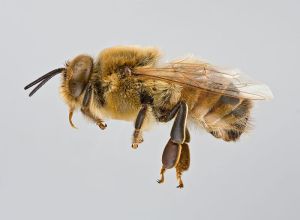A therapy with dead bees may sound intriguing, morbid, and completely repulsive. More disgusting than killing baby bees and eating them (of course, after they were turned into a product called Apilarnil). But to eat them after they died…
Tradition teaches us how to take advantage of bees all the time, when they are young, when they are adults and after they die. I love honey, pollen, and propolis, but this is massive exploitation, if you ask me. Like a sort of revenge for refusing to be domesticated and for always stinging us.
The products are mostly found in Russia and Slovenia and dead bees are called PODMORE. From them, apitherapists turn dead bees into decoctions, tinctures, ointments, or even fried bees. 🫣
Is Apilarnil the same thing as dead bees? Not exactly!
Where can we find dead bees?
Honey bees have different lifespans according to gender and season.
– Male bees (aka drones) can live between 32 and 58 days. If there is no mating flight and winter is coming, the drones will be expelled from the hive by the workers, as there is no use for them in the winter.
– Working bees live for like 35 – 42 days (6 weeks) during summer, and for around 120 – 270 days (4-9 months) during the winter months. (Read more: The jobs of a bee. What is the life of a bee?)
Good dead bees (how strange this sounds!) must be well-preserved, bone-dry, and free of mold. Some people say they have a specific smell, somehow sweet, slightly similar to the scent of dried fish. Other people say dead bees smell like the crust of fried pancakes, roasted seeds, or dry cat food.
Where can one find dead honey bees?
Dead bees are not easy to collect. During the summer, healthy bees choose to die in the field, not in the hive. It’s part of their culture of keeping the hive clean and healthy and their never-ending working effort.
Those that miss their last flight in the field are quickly expelled from the hive by the other bees. A beekeeper never finds dead bees inside the hive, during the summer. Yet, these dead bees are the most valuable now, because they contain a large amount of nutrients.
The greatest number of dead bees beekeepers can find is in spring, at the bottom of their hives, when they clean the hives. There can be 0.5 kg of dead bees in every hive.
Sick honey bees, whether treated or not, should not be used.
To make the products, honey bees are first put through a large thieve to eliminate the impurities found in the hive. Then they must be dried. This is done in an oven at a temperature of maximum 50° C. After that, they can be kept in sealed boxes, glass jars, or in the freezer. Some beekeepers suspend the dried bees in canvas bags in a dry, ventilated place and thus store them for a long time.
And yes, we can buy dead bees from beekeepers at honey fairs.
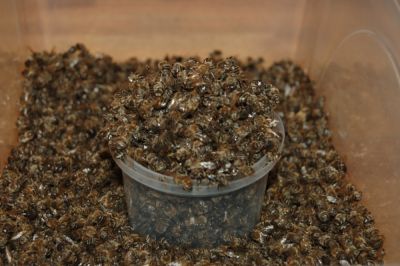 picture source polzovred.ru
picture source polzovred.ru
The composition of dead bees
Probably the most important substance is chitin, but there are also others such as heparin, melanin and glucosamine. And of course, bee venom (which is very resistant to high temperatures and thus, even at 50° C, it maintains its unique properties).
What is chitin?
Chitin is a large, modified polysaccharide that contains nitrogen and is found in the exoskeletons of insects, the cell walls of fungi, and certain hard structures in invertebrates and fish. It is mostly used as surgical thread and binders for dyes and glues, because chitin is a biodegradable molecule.
It is often used as a food thickener and stabilizer, and it can also form edible films. Chitin also has many applications as a health supplement that primarily relate to its role as a dietary fiber. Health supplements typically use chitosan, which is a modified form of chitin with greater bioavailability.
The effect of chitin on our health includes the normal functioning of the thyroid gland and reducing to the minimum the occurrence of diseases associated with this gland. It also accelerates the healing of injuries and wounds.
From chitin, chitosan is made. Chitosan is a sugar that is obtained from the hard outer skeleton of shellfish, including crab, lobster, and shrimp. It is available as a supplement in our health shops everywhere.
Bee fat is a very important component, as the major site of insect metabolism and nutrient storage is not the brain but rather the fat body. The fat body is analogous to the mammalian liver and adipose tissue, with nutrient stores that often correlate with behavior.
The honey bee’s fat body influences endocrine state and behavior by secreting the yolk protein precursor vitellogenin (Vg), which suppresses lipophilic juvenile hormone and social foraging behavior. (study)
It is considered that bee fat is better than fish oil, providing a more complete set of polyunsaturated fatty acids. It is easier to digest, does not lead to sharp fluctuations in blood sugar levels. Fat bees can serve as raw material for synthesis in the human group of eicosanoids – potent regulators of many bodily functions, that eliminate the risk of cardiovascular disease, support the immune system, promote the healing of damaged tissues, and perform pain control.
In large quantities, bees’ bodies are dietary fibers, which improve the secretory function of the gastrointestinal tract. It is a lovely sorbent, that releases toxins from the body of endogenous (food impaired metabolism and inflammation, excess cholesterol, uric acid, obsolete and damaged cells) and exogenous (salts of heavy metals, radionuclides, pesticides, herbicides, alcohol, and drugs).
Heparin, another substance present in bee’s body, combined with glucosamine, bee venom, and melanin, is able to establish the metabolic processes in the body, to restore the biological balance, strengthen the immune system, to improve the condition of blood vessels, and normalize the pressure drop.
Apitoxin, from bee venom, is able to increase hemoglobin levels, increase blood vessels, normalize sleep and appetite and improve the general condition.
Other compounds: 27 micronutrients, including calcium, chromium, aluminum, silver, iron, copper, molybdenum, magnesium, silicon, phosphorus, zinc; vitamins – E, K, D, P, C; proteins, amino acids, fibers.
Health benefits of dead bees therapy
According to webmd chitosan (which is made from chitin – the major constituent of dead bee products), is used in allopathic medicine to treat:
– obesity
– high cholesterol (though there is conflicting evidence about its effectiveness)
– Chron’s disease
– complications in dialyzed patients (kidney failure)
– “tired blood” (anemia)
– loss of strength and appetite
– trouble sleeping.
– prevent periodontitis when directly applied on gums, and also prevents tooth cavities when the chewing gum contains chitosan.
– helps the skin rebuild itself. Plastic surgeons often apply chitosan directly to places from which they have taken tissue (the donor) to be used elsewhere.
In pharmaceutical manufacturing, chitosan is used as a filler in tablets; as a carrier in controlled-release drugs; to improve the way certain drugs dissolve; and to mask bitter tastes in solutions taken by mouth.
Tradition also tells us that dead bee products are very useful for the digestive system: cleanse the intestines and normalize their function, relieve intestinal pressure, reduce the absorption of toxins, thus preventing gastrointestinal disease and prevent colorectal cancer. They also reduce the risk of diabetes and restore appetite.
The products are antiviral and antibacterial, antioxidant and antitoxic, hepatoprotective and radioprotective.
Good results were observed during the treatment of:
– prostate adenoma
– nephritis and kidney stones,
– hypertension, atherosclerosis,
– diabetes,
– asthenic syndrome,
– osteochondritis, arthritis, rheumatism,
– felon, furunculosis, burns,
– impaired sexual function,
– bad memory,
– loss of vision (myopia) or hearing.
Cautious:
Warfarin (Coumadin), a blood thinner, interacts with chitosan, which might increase the blood thinning effects of warfarin.
If you are allergic to bee venom do not take it.
Dead bees products:
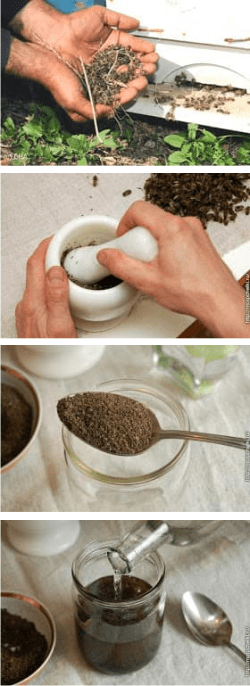 Tincture (alcoholic extract).
Tincture (alcoholic extract).
Because we are talking about Russian traditional medicine, this extract is made using good quality vodka. But it can be done using any other 40°+ alcoholic drinks like whisky, gin and so on.
In a glass bottle/jar put 30 g (one cup) of powdered dead bees and cover with 0.5 liter of vodka or alcohol. Keep it for 2 weeks in a cool, dark place. Filter and store the liquid in a dark glass container. It is recommended for the treatment of benign prostate hyperplasia and sexual dysfunction – impotence and frigidity, kidney disease, glomerulonephritis and obesity
Dose: Adults: 15-20 drops after meals, for 1-2 months. Older people: 1 drop /year of life (eg. .70 drops for a 70 yo man) for 6 to 12 months. Their health condition will visibly be improved. It helps in hypertension, with cardiovascular diseases, diseases of the kidneys, liver, blood vessels of the brain, “cystic proliferation” of the thyroid gland.
To cleanse the liver from lamblia, take 20-30 drops of tincture (but not more!) 3 times a day after meals for 1 month.
To cleanse the blood Take the same, only add to the infusion of the powdered leaves of eucalyptus (10% of the weight Podmore). Applied topically for the treatment of wounds.
Fried Dead Bees (!)
1 teaspoon fresh dead bees are roasted in 50 ml vegetable oil for 5-6 minutes. Let them cool and then ground them. Take 1 teaspoon before meals, with milk, for 1-2 months. The treatment can be repeated after 2-3 months. It is said it treats myopia.
Steamed Dead Bees
Pour 100 g dead bees into hot (but not boiling) water and leave for 15 minutes. Slightly squeeze the bees through 3 layers of gauze to remove the extra water and apply them on the inflammation. Cover with plastic wrap and secure it with a rubber band.
Dead bees decoction
Pour 1 tablespoon of dead bees into 0.5 liters of boiling water, bring to a boil, and cook over low heat for 2 hours. Then left to cool at room temperature for 1-2 hours. Strain the broth and take 1 tablespoon twice per day, half an hour before meals, for a month. Simultaneously, drink a teaspoon of honey in half a cup of warm water. After 1 month take a break of 2 weeks and repeat the course 2-3 times.
It helps with prostate cancer, kidney disease, glomerulonephritis, and obesity. Simultaneously, drink half a cup of warm water, spreading it in 1 teaspoon of honey.
Dead bees ointment
Ground the dead bees into powder. Mix 1 tablespoon of powder with 200 ml hot olive oil. Let it cool and store in a dark glass jar in the refrigerator. Heat it before rubbing your painful area with it. It is very useful in joint pain and thrombophlebitis.
For those of you who understand Russian, here is a video on how to make dead bee decoction. And even if you don’t understand the language (my case), you can still understand the process.
There is no voodoo here. History confirms it.
Galen, the famous Roman physician, used crushed honey bees for carbuncles, gum disease, to restore hair growth, and to relieve tooth aches in infants. The Roman philosopher Pliny pointed out that the ash of burnt bees, mixed with oil made a good remedy for many ailments. Ash mixed with honey should be consumed for eye diseases to grow and strengthen hair.
Bees, cooked in honey, were also used for dysentery, and a decoction of bees was used as a diuretic.
British medical books from the XVII century encourage us to take dried bees with milk and wine for dropsy, rheumatism, urinary stones, cramps and abdominal pain, bloody diarrhea, ulcers, and weeping herpes.
References:
Featured picture credit: richardoyork via flickr.com
apiterapie.info
mymedinform.com
polzovred.ru
bestwomandiary.com
great-beemaster.blogspot.ro

